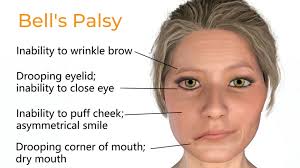Distinguishing between bell’s palsy vs stroke is crucial for timely and effective treatment, impacting patient outcomes significantly. Both conditions affect facial muscles but have different causes, symptoms, and treatments. Understanding the distinction between bell’s palsy vs stroke is not only important for medical professionals but also for the general public to ensure prompt medical attention is sought when necessary.
Understanding Bell’s Palsy
What Is Bell’s Palsy?

Bell’s Palsy is a temporary condition characterized by sudden, unilateral facial paralysis or weakness. It results from inflammation or compression of the facial nerve (cranial nerve VII), which controls the muscles on one side of the face. This condition can affect anyone but is most common in individuals between the ages of 15 and 60. Unlike stroke, bell’s palsy vs stroke shows that Bell’s Palsy typically resolves on its own over time, with most patients recovering fully with or without treatment.
Symptoms of Bell’s Palsy
bell’s palsy vs stroke can be distinguished by the specific symptoms associated with Bell’s Palsy, which include:
- Facial paralysis or weakness on one side of the face, noticeable when trying to smile or close the eyelid.
- Drooping of the mouth on the affected side.
- Increased sensitivity to sound on the affected side.
- Decreased taste on the front two-thirds of the tongue.
- Eye problems, such as dry eye or inability to close the eyelid, leading to tears flowing down the face.
Causes and Risk Factors of Bell’s Palsy
The exact cause of Bell’s Palsy remains unknown, but it is often associated with:
- Viral infections such as herpes simplex, which cause inflammation and swelling of the facial nerve.
- A history of respiratory illnesses or flu-like symptoms preceding the onset.
Risk factors include:
- Pregnancy, especially during the third trimester.
- Diabetes.
- A recent upper respiratory infection, such as the flu or a cold.
Diagnosing Bell’s Palsy
Diagnosis primarily involves ruling out other causes of facial paralysis. Tests may include:
- Electromyography (EMG) to assess the extent of nerve involvement.
- Imaging tests, such as MRI or CT scans, to exclude other possible causes like tumors or stroke.
Treatment Options for Bell’s Palsy
Treatment aims to accelerate recovery and reduce complications:
- Corticosteroids to reduce inflammation and swelling.
- Physical therapy to stimulate the facial nerve and muscles.
- Eye protection to prevent damage due to inability to blink.
- Antiviral medication if a viral infection is suspected to be a contributing factor.
Understanding Stroke
What Is a Stroke?

A stroke occurs when a portion of the brain’s blood supply is cut off or stopped leading to oxygen and nutrients deprivation to brain tissue . There are two basic categories of strokes:
- Ischemic strokes, caused by blood clots obstructing the flow of blood to the brain.
- Hemorrhagic strokes, caused by bleeding within or around the brain.
Unlike Bell’s Palsy which involves only the facial nerve, a stroke affects the brain itself and requires immediate medical intervention to prevent long-term neurological damage or death.
Symptoms of a Stroke
Stroke symptoms can vary but often occur suddenly and may include:
- Sudden numbness or weakness in the face, arm, or leg, especially on one side of the body.
- Confusion, trouble speaking, or difficulty understanding speech.
- Trouble seeing in one or both eyes.
- Dizziness, imbalance, difficulty walking, or lack of coordination.
- Severe headache with no known cause.
Causes and Risk Factors of Stroke
Factors that can lead to a stroke include:
- The primary risk factor is high blood pressure.
- Heart disease, including atrial fibrillation.
- Diabetes.
- Smoking and excessive alcohol use.
- Obesity.
Diagnosing a Stroke
Rapid diagnosis is critical for effective treatment of a stroke. Methods include:
- Computerized Tomography (CT) scans to visualize the brain.
- Magnetic Resonance Imaging (MRI) to detect brain tissue damage.
- Blood flow tests such as carotid ultrasound and cerebral angiography.
Treatment and Recovery from Stroke
Treatment for stroke might include:
- Emergency IV medication to dissolve blood clots in ischemic stroke.
- Mechanical thrombectomy to physically remove clots.
- Surgery to repair brain bleeding and reduce pressure in hemorrhagic stroke.
- Rehabilitation including physical, occupational, and speech therapy.
Comparing Bell’s Palsy vs Stroke

Understanding the differences and similarities between bell’s palsy vs stroke is crucial for accurate diagnosis and treatment. Here’s a comprehensive comparison:
Similarities and Differences
- Affected Area: Bell’s Palsy affects the facial nerve leading to paralysis of facial muscles on one side, While a stroke damages brain tissue and, depending on the section of the brain affected, can affect other parts of the body.
- Symptoms: Both can cause facial drooping. However, stroke symptoms extend beyond the face, including limb weakness, speech difficulties, and severe headache.
- Onset: Symptoms of both conditions can appear suddenly.
- Causes: Bell’s Palsy is often linked to viral infections affecting the facial nerve, while strokes are caused by blood clots or bleeding in the brain.
- Treatment: Treatment for Bell’s Palsy may include steroids and physical therapy, whereas stroke treatments focus on restoring blood flow to the brain and managing symptoms through rehabilitation.
Why Quick Differentiation Is Crucial
Quickly differentiating between bell’s palsy vs stroke is vital due to the urgent need for treatment in stroke cases to minimize brain damage and potential long-term disabilities. Immediate medical evaluation ensures that patients receive the correct diagnosis and treatment, highlighting the importance of recognizing the signs and symptoms of each condition.
Living with Bell’s Palsy or Stroke
Recovery and Rehabilitation
- Bell’s Palsy: Most individuals recover fully within 3 to 6 months, with or without treatment. Physical therapy may help speed recovery.
- Stroke: Recovery varies greatly among individuals; some recover fully, while others may have long-lasting disabilities. Rehabilitation can improve function and independence.
Long-term Management and Support
- Bell’s Palsy: Long-term effects are rare but may include partial facial weakness or involuntary movements.
- Stroke: Long-term effects can include paralysis, cognitive deficits, and speech problems. Support from therapists, support groups, and family is crucial for adaptation and recovery.
Preventative Measures
Reducing the risk of both bell’s palsy vs stroke involves:
- Healthy lifestyle choices: Regular exercise, a balanced diet, and avoiding smoking.
- Managing chronic conditions: Keeping diabetes, hypertension, and cholesterol under control.
- Regular health check-ups: Early detection and management of risk factors.
Conclusion
Distinguishing between bell’s palsy vs stroke is essential for providing the correct treatment promptly. Awareness and understanding of the signs and symptoms of each condition can lead to faster diagnosis, better outcomes, and a more informed public.
FAQ Section
Can Bell’s Palsy Lead to Stroke?
No, Bell’s Palsy does not lead to stroke, as they have different causes and affect different parts of the nervous system.
How Long Does Bell’s Palsy Last Compared to Stroke Symptoms?
Bell’s Palsy usually improves within 3 to 6 months, while stroke recovery can vary widely among individuals, with some effects possibly being permanent.
Are There Any Lifestyle Changes That Can Help Prevent Both Conditions?
Yes, maintaining a healthy lifestyle, managing chronic health issues, and avoiding risk factors like smoking can help lower the risk of both conditions.
READ ALSO:
-
Acetaminophen Codeine: Comprehensive Guide to Effective Pain Management
-
High Heart Rate When Sick: Causes, Management, and Prevention
-
5 Proven Strategies to Combat Broken Blood Vessels on Face: Essential Tips for Flawless Skin
-
Understanding Blurred Vision ICD 10 Code H53.8: Comprehensive Insight and Guidelines
